
Surfaces
A wide range of equipment dedicated to the study of the surfaces is housed at DiSC. The initial core of the equipment has been acquired in 1988, thanks to a serious financial support, then it has been continuously upgraded, integrated, expanded and sometimes reassembled. Among the actually applied techniques, we can mention here the X-ray photoelectron spectroscopy (XPS), the X-ray photoelectron diffraction (XPD), the low energy electron diffraction (LEED), the thermal desorption spectroscopy (TDS), also known as temperature programmed desorption (TPD) and the Scanning Transmission Microscopy (STM). Conditions of ultra high vacuum (UHV) are widely applied in these techniques.
Some of the DiSC Surface Analysis instruments are reported below:
Angle resolved-XPS - XPD UHV system
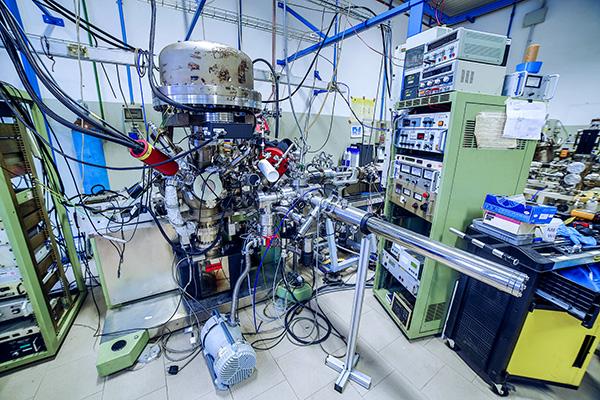
This equipment is characterized by:
- High precision VT manipulator (RT – 1000 K) capable of x,y,z translations, polar rotation (around the manipulator axis itself) and azimuthal rotation (around the normal to the sample surface) with an angle resolution better than 0.5°;
- VG hemispherical electron analyzer (150 mm mean radius) ending with a five channeltron detector whose angular acceptance can be varied between 1° and 8° by using different kinds of slits and acting on an iris. This, in association with the motion capabilities of the manipulator, allows the mapping of the intensity of a selected photoemission line over the entire 2pi hemisphere above the sample (XPD capability). The analyzer can operate both in constant analyzer energy mode (XPS experiments) and constant retard ratio mode (AES measurements);
- Omicron DAR 400 double anode (Mg-Al) X-ray source;
- Omicron VUV HIS 13 UV source (He I and He II) for valence band measurements;
- Omicron 4-Grid SPECTALEED;
- VG EX03 Ion Gun System;
- SPECS EBE-4 e-beam triple metal evaporator, water cooled.
contact: gaetano.granozzi@unipd.it ; stefano.agnoli@unipd.it ; gianandrea.rizzi@unipd.it
location at DiSC: 215-01-045
TPD UHV system
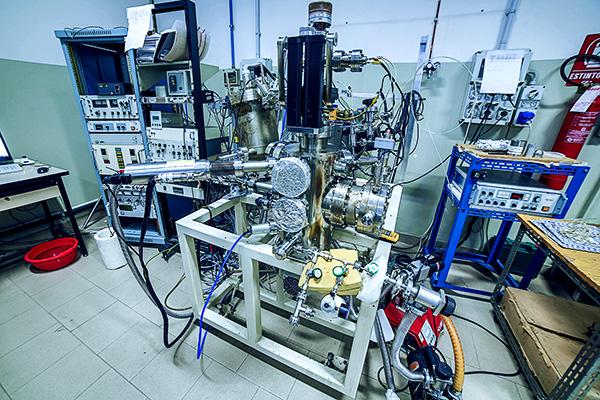
This custom-made TPD system has been designed for catalysis studies and is equipped with:
-VT manipulator (from 110 to 1000 K), x, y, z and θ (from 0° to 180° and from 0° to -180°) sample movement;
- Hidden Quadrupole Mass Spectrometer for Temperature Programmed Desorption (TPD) measurements (closest distance to the sample = 1 mm);
- Omicron 4-Grid SPECTALEED;
- Omicron ISE 5 Ion Source;
- Omicron EFM 3/4 e-beam metal evaporator, water cooled.
contact: gaetano.granozzi@unipd.it ; stefano.agnoli@unipd.it ; gianandrea.rizzi@unipd.it
location at DiSC: 215-01-045
XPS-UHV system combined with electrochemistry

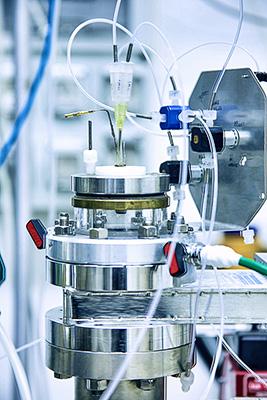
Custom-designed UHV system that consists of two independent UHV chambers: a preparation/analysis chamber and an electrochemical (EC) chamber.
In the preparation/analysis chamber, several evaporators and gas valves are available, as well as an argon sputter gun, for the preparation of the samples. This chamber is also equipped with an Omicron 4-Grid SPECTALEED, an EA 125 Omicrom electron analyzer with five chaneltrons and a non-monochromatized anode (Al Kα/Mg Kα) X-ray source for X-ray photoemission spectroscopy (XPS) measurements and counts with a High precision VT manipulator (RT – 1000 K) capable of x,y,z translations and polar rotation (around the manipulator axis itself).
The EC chamber is connected to the preparation/analysis chamber through an UHV-EC transfer system, which consists of two manipulators (horizontal and vertical) that allow the coupling with the EC cell. The EC cell is a custom made PEEK (polyether ether ketone) cell equipped with a Pt wire (counter electrode) and an Ag/AgCl/Cl- (3M KCl) electrode placed in a Luggin capillary (reference electrode). The cell is controlled by an Autolab potentiostat running with NOVA Software. The EC measurements can be performed in different solutions that are pumped into the EC cell through a tubing system using a syringe pump (N-1010, Pump Systems Inc.), which allows an accurate control of the flow.
This UHV-EC system allows to combine in situ XPS and electrochemical measurements in order to determine the chemical changes induced in the materials due to the electrochemical work.
contact: gaetano.granozzi@unipd.it ; laura.calvillolamana@unipd.it ; gianandrea.rizzi@unipd.it
location at DiSC: 215-01-163
PHI 5600 ci XPS-Auger spectrometer
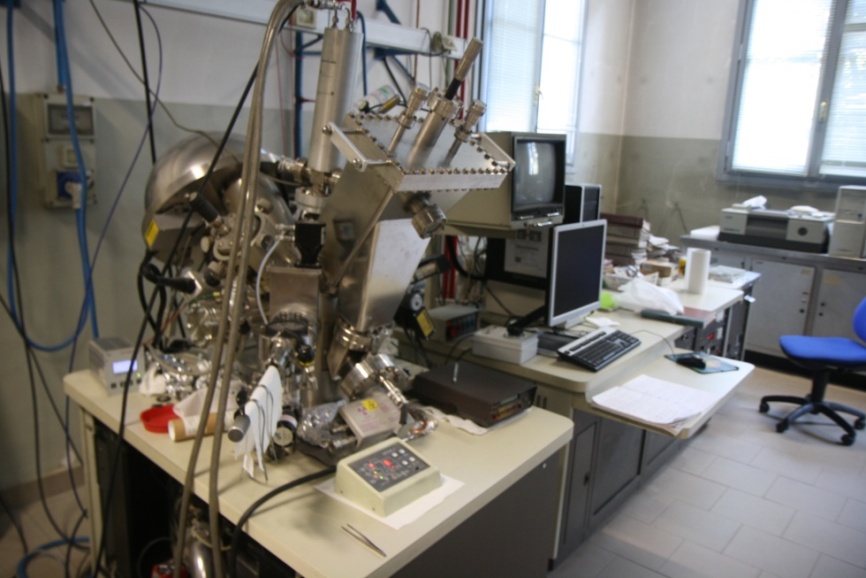
Multi-technique spectrometer equipped with AlKα, MgKα and monochromatized AlKα X-ray sources, and an ion-gun for surface and in-depth compositional analyses. The system enables quantitative element determination at surfaces of solid materials by spectroscopy of emitted photoelectrons and gives information on the chemical states by analysis of peak-shifts or peak-shape changes.
contacts: lidia.armelao@unipd.it ; renzo.bertoncello@unipd.it ; alberto.gasparotto@unipd.it ; antonella.glisenti@unipd.it ; silvia.gross@unipd.it
location at DiSC: 215-01-045
Scanning Tunneling Microscopy (STM)
An Ultra High Vacuum (UHV) facility focused on the deposition and characterization of organic molecules on conductive and semi-conductive surfaces.
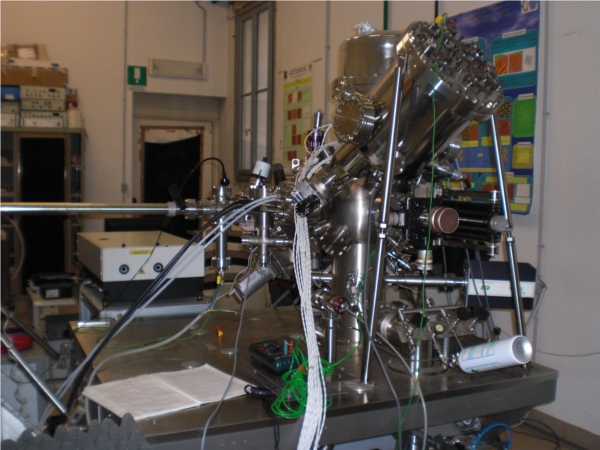
Preparation tools:
Sputtering: Omicron ISE 10 sputter ion source;
Deposition: Omicron EFM3T triple evaporator for metals from rod and crucible with integrated flux monitor; MBE-Komponenten NTEZ 40 effusion cell for organic molecules; MolecularSpray UHV4 electrospray deposition system for thermolabile/non volatile molecules.
Light treatment: EKSPLA NT342A tunable Laser source in the wavelength range from 210 to 2600 nm, with an output power of 40 mJ at 355 nm, producing pulses in the range 3 to 5 nanoseconds with a repetition frequency of 10-20Hz and several cw monochromatic laser sources.
Analysis tools:
Scanning Tunneling Microscopy (STM): Omicron variable temperature (77-1500 K) system;
Low Energy Electron Diffraction (LEED): OCI LPS075D rear view display with integrated camera;
X-ray photoelectron spectroscopy (XPS): Scienta MX650 monochromatic Al Kα source and Scienta SES 100 hemispherical electron analyzer ending with a micro-channel plate.
contacts: mauro.sambi@unipd.it
location at DiSC: 215-01-053





